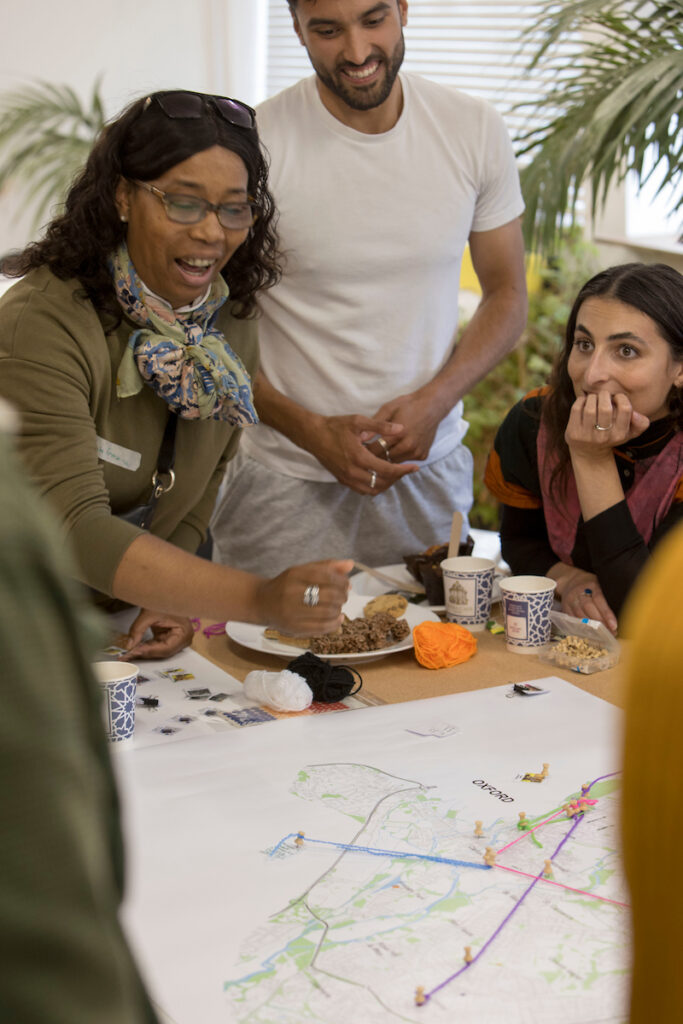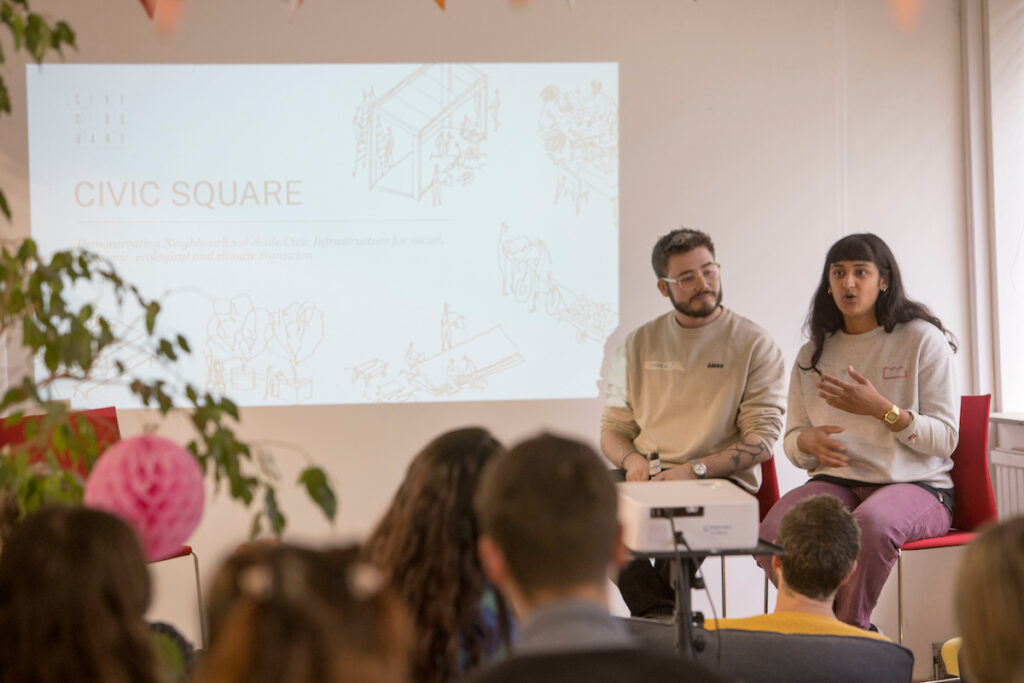Open Doors 365: Our response to Oxford Open Doors
[You can also read this blog on Medium]
Open Doors Weekend is a major event in everyone’s calendar. People get to pop in and explore some of the wondrous buildings we have on our doorstep. So, we wanted to take the opportunity this year to ask the question;
What if Oxford’s resources and spaces were open all year round?
We believe it’s critical to make space for radical imagination, opening our spaces up for events and discussions, built around the principles of spatial justice*. We invite those already creating the long-term, transformational change that we want to see across Oxfordshire to share their ideas. This week, the spotlight was on CIVIC SQUARE.
For Oxford Open Doors this year, we hosted a series of fringe events: a counter-mapping workshop with Oxford Spatial Action Lab, and a panel event with CIVIC SQUARE, Transition by Design and Oxford Community Action.
Motivated and still on a high, we wanted to run you through some of the key elements of what was discussed, and how this fits into our thinking and planning for the kind of infrastructure we think Oxford’s communities need in the future.
“Infrastructure, at its most fundamental level, is not about roads and bridges, cables and concrete. It’s about who we are, what we value, and what kind of society we want to create.”
— Eric Klinenberg.
First, we invited Oxford Spatial Action Lab and local citizens to collaborate with us on a counter-mapping workshop. Together we shared stories of Oxford’s social infrastructure – the spaces and places where people build connection and belonging outside of home or work.

Counter-mapping workshop with Oxford Spatial Action Lab
We surfaced and celebrated the spaces that mattered to people; past and present. Places that shape the identity, culture and community of Oxford, centred around grassroots perspectives and the experiences of local people.
We then imagined ourselves a generation into the future and asked, ‘What forms of social infrastructure do we need to meet our needs and dreams for a fairer, more regenerative city?’
There’s an innate love, care and belief from our immediate community, residents and partners, who are working tirelessly to tackle the important issues we face today. Whether those are social, economic or ecological, or all three; a better understanding of the 21st century polycrisis is allowing us to reimagine what is possible and how these transformations may look.
One such example is the community action to improve the Leys neighbourhood in Oxford. The repeated phrase “but, it’s not impossible” reminded us of the slogan “there is no alternative”, popularised by Margaret Thatcher in the 80s. This is how we feel about the work that we do.

Counter-mapping workshop
There is a huge ecosystem working towards repairing, hospicing and nurturing new ways of being. Not least those who work with. And we’re privileged to be part of one emerging, shining example: a new peer network for a community assets network.
Now we want to work together locally to set bolder ambitions for Oxfordshire: to make communities working to transform their neighbourhoods the beating heart of new emergent systems.
“We need to prove that we can keep going and distributing resources. There is an assumption around that ‘these people’ can’t do the work, or that they can’t be trusted”
– anonymous comment during Oxford Open Doors 365
We know first hand that to transform a neighbourhood takes incredible levels of ambition and grit. It’s deep, long-term work. During the evening panel discussion, our friends from CIVIC SQUARE shared their decade-long journey from creating Impact Hub Birmingham, to developing a new vision for a Neighbourhood Public Square demonstrator in Ladywood.
Kavita and Charlie spoke about how they are creating physical and civic infrastructures to lever social – ecological system change from the scale of the neighbourhood. They see this not as an option, but a necessity to meet the challenge of the polycrisis they’ve set out so rigorously in 3ºC Neighbourhoods.

Charlie Edmonds & Kavita Purohit, Civic Square
We discussed how they’ve transformed their site into a living classroom, a place for prototyping, community building, as well as imagining new ownership and economic models. This is built on research with Dark Matter Labs laid out eloquently in Endowing the Future. Their proposal to transform the Physical Infrastructure Design from derelict warehouses into a demonstrator hub built on regenerative design principles is both stunning and inspirational.
Each facet of this work is underpinned by a question: a central organising enquiry that drives their work and we feel gets to the heart of spatial justice:
“What if the climate transition and deep retrofit of our homes, streets and neighbourhoods were designed, owned and governed by the people who live there?”
– CIVIC SQUARE
Charlie described how to be sustainable isn’t enough any more; we need to also repair and create positive, regenerative impacts. In a nutshell, being sustainable means doing no harm and ensuring future generations have the same resources as we currently do, whereas to be regenerative offers a chance to actively “do good” and create more capacity, resources, skills and tools for the future generations.
Kavita highlighted the importance of avoiding ‘carbon tunnel vision’ when responding to the climate emergency, instead thinking about wider health and ecological impacts, as well as where the materials needed for just transition will come from;
“+1.5°C is a new age of Imperialism, embedded in the global north’s most ambitious climate action plans, are contemporary structures of colonialism, extractivism and the externalisation of ecological impacts on the global south.”
– Kavita Purohit
A connected theme kept coming up in discussion across the day – one of racialised risk. In the past, funders would fear supporting projects led by people from the global majority – a legacy of colonial thinking and structural racism highlighted by local reports like Pamoja, and national studies from organisations like Ubele and Voice4Change.
We purposefully invited CIVIC SQUARE to join us for Oxford Open Doors 365 because we have been so deeply inspired by their work. Their presence gave us the opportunity to delve into these systems issues, their day-to-day organising, response and struggles. They have shown us how to make change happen right now, in both visionary and practical ways. CIVIC SQUARE are also conscious that world-building work requires simultaneously looking towards the futures we hope to create, whilst dealing with the day-to-day challenges of the dominant systems we are all currently in, and shared some of the realities of the challenges they are navigating in this light
“Oxford is divided in its own special way. For such a small city it has managed to not only maintain but also increase some of the steepest social gradients found anywhere in Europe”
– Danny Dorling (2018)
These offerings from CIVIC SQUARE were then contextualised by local organisers Nigel Carter, Oxford Community Action, and Liv Harrison, from Transition by Design, who highlighted some of the work that has taken place in Oxford over the years.
Nigel spoke about building local capacity through Community Wealth Building initiatives like Owned by Oxford, and Oxford Community Action’s work which contributed to Oxford’s Citizens Assembly on climate change. Complementary frameworks like Marmot Cities, which place emphasis on health and health inequalities, were discussed alongside autonomous and spontaneous displays of community power in the form of occupations and the recent demonstrations against the far right. Liv emphasised the critical role of community led retrofit initiatives exercised through her role at ACAN and Transition by Design.
“Today offered a foundation for the way in which we must organise ourselves and gives us another layer of confidence. This is how we’ll get there.”
– Andy Edwards
So we come back to what would happen if Oxford’s resources and spaces were open all year round. Typically, it brings up big questions around land ownership, which is at the heart of so many of the challenges we face.
Thanks to our visitors and collaborators, we learned and recognised how to reuse and revalue the resources we already have in abundance.
It may be complex and messy. It may be multi-generational work. But we feel that if we can first reimagine and then redesign better ways of sharing our land, buildings and resources – and seeing them as belonging collectively: as a commons for all to enjoy – we can simultaneously transform our neighbourhoods and our world.
Our next steps as an organisation are to harvest the shared learning from our workshop and talks. We are particularly inspired by CIVIC SQUARE’s chapters on their Neighbourhood Public Square from Spring/Summer 2024 and will be raising our own ambitions, drawing on these compelling works.
What has become clear after Oxford Open Doors 365, is that by pooling resources, experiences and knowledge, we are stronger for it.
Here’s to making Oxford open all year round, accessible by all!
*We have more coming soon on unpacking what spatial justice means to Makespace Oxford, through a future publication. For now there’s there’s excellent ideas and offers from Edward W Soja amongst others.
____
Special thanks to Kavita, Charlie and Brodie and the whole CIVIC SQUARE team for sharing their work and ideas so generously.
Thanks to Sylvia, Tiger and Alex from the Oxford Spatial Action Lab for co-convening the workshop, and to Liv Harrison and Nigel Carter for their insights on the panel.
Thank you also to Adrian Arbib for the brilliant photographs, and to the dozens of local groups and citizens who joined us across the day.
And huge thanks of course to Oxford Preservation Trust for the impulse and their commitment to opening up Oxford’s spaces each year.